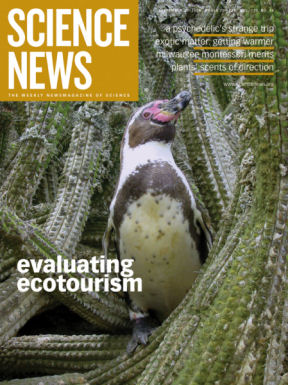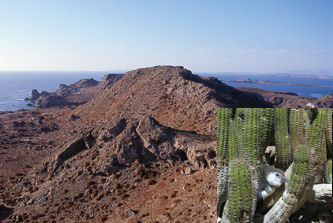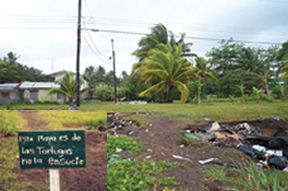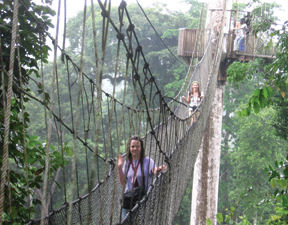The island of Damas is a half-hour boat ride from the Chilean coast. On the island, it’s dry and rocky. The Humboldt penguins that live there have no ice slopes to slide down in their black-tie apparel. Instead, these desert penguins seek out caves to shade their eggs from the sun. If they can’t find a spot beneath a boulder, they may burrow into seabird dung. Sometimes, they nest inside a cactus.




To see these penguins, visitors usually begin in La Serena, Chile. They drive 40 miles north on a main highway and then cut toward the coast on a gravel road that leads to the fishing village of Punta de Choros. Local fishermen there charge a fee to guide the tourists to Damas by boat. On the island, people are free to walk into the caves where the penguins live. Anyone can watch a mother brooding an egg and snap a picture with a flash camera or a mobile phone.
What began in the early 1990s as a place with a few hundred curious visitors has now become a tourism destination that attracts 10,000 penguin peepers a year. Damas provides an example of ecotourism, defined as the practice of visiting sites where exotic landscapes and rare animals are the main attractions. Ideally, ecotourists learn about the habitats that they visit, provide donations to conserve them, and generate income for host communities.
Since this model of tourism emerged some 25 years ago, many special-interest sites, like Damas, have experienced hikes in visitation. Often, ecotourism is a wild success (SN: 12/3/05, p. 364: Available to subscribers at Valuing Nature). The United Nations even billed 2002 the “International Year of Ecotourism.”
But several recent studies show a more complicated picture of the impact of ecotourism, a practice that remains largely unregulated. The increased crowds lead to population changes in some animals, such as the Humboldt penguin and, some 4,000 miles away in the Bahamas, the Allen Cays rock iguana. A mounting garbage problem caused by over-visitation by turtle viewers threatens the beaches of Tortuguero in Costa Rica. People who live near Ghana’s Kakum National Park have lost access to the forest’s resources and now suffer high rates of unemployment.
“There comes a time when you have so much interference through ecotourism that you affect the thing you’re trying to protect,” says Robert E. Hueter of the Mote Marine Laboratory in Sarasota, Fla., who studies ecotourism’s impact on whale sharks. Ecotourism’s benefits to conservation and public education are considerable, he says, but the downsides may take a long time to recognize.
“I think there’s been a glib … championing of ecotourism, that it’s a win-win situation,” says Martha Honey, executive director of the Center on Ecotourism and Sustainable Development in Washington, D.C. But by studying how animals, environments, and cultures respond to ecotourism, “we can set up systems that aren’t having adverse impacts,” she says.
Flight of the penguins
Ursula Ellenberg decided to study how human disturbance affects the Humboldt penguins when she was quietly counting their population, but not quietly enough. While she was looking through binoculars from a cliff about 150 meters away, the penguins began racing in all directions. One of the penguins had spotted Ellenberg, despite her unobtrusive perch. If a cautious researcher can spark such a reaction, she thought, how would the penguins react to a gaggle of shutter-happy tourists?
To study the effects of human-Humboldt interaction, Ellenberg and her colleagues measured the breeding success of penguins on the islands of Damas, Choros, and Chanaral, which together make up the Humboldt Penguin National Reserve. The island cluster serves as a good point of comparison: Damas receives 10,000 annual visitors, but Choros and Chanaral are much less accessible from the mainland and attract only 1,000 and 100 tourists a year, respectively.
Ellenberg’s team was the first to study these penguin populations. The researchers monitored eggs and chicks on each island for 5 months after the penguin mothers laid the eggs. If a nest is abandoned during this period, the chicks usually die. Penguins have many chances to breed during their 20-year life spans, and they would sooner abandon a nest than risk personal harm—say, from an approaching human.
In 2003, the only year that Ellenberg’s group studied Chanaral, the penguins there bred an average of 1.34 chicks. On Choros, the average was just below one chick in both 2002 and 2003. But on Damas, female penguins produced, on average, a little less than half a chick in 2002, and the birthrate dipped well below a quarter of a chick in 2003, Ellenberg’s team reports online and in the November Biological Conservation.
“It’s surprising, when you have islands at such close proximity, that you’d already get a difference,” says Ellenberg, a biologist at the University of Otago in New Zealand. “They should do similarly well.”
Working in the Bahamas, John Iverson of Earlham College in Richmond, Ind., has discovered similarly detrimental effects of human presence on Allen Cays rock iguanas, an endangered species.
When Iverson began studying these animals 25 years ago, ecotourism was just under way. At that point, male iguanas outnumbered females two to one. Historically, fishermen had captured iguanas to sell or eat, and female iguanas were easier to trap because they guard their nests rather than flee an intruder. Iverson and Geoffrey Smith of Denison University in Granville, Ohio, propose in an upcoming Canadian Journal of Zoology that poachers created the observed gender imbalance.
Enter ecotourism. As island management increased protection of its main attraction, poaching declined. The balance of the sexes was restored remarkably quickly. Iverson and Smith found that the increased survival of females that came with the end of poaching wasn’t the whole story. Male iguana numbers declined as ecotourism increased, they say.
As part of the study, Iverson and Smith in 2000 tagged the largest male iguanas in two ecotourism areas. At one site, the number of tagged iguanas fell from 30 to 9 by 2005. Using death rates calculated from the previous 20 years, the researchers had predicted that 16 would survive. At the other site, the researchers found none of the 17 tagged iguanas in 2005, though they had expected 9 animals to remain.
Part of the problem, the researchers argue, is that the males tend to be aggressive and interact more with human visitors than females do. Some of the 54,000 people who visit the area each year feed the iguanas hazardous material such as spoiled food or Styrofoam, which can kill them.
But Iverson and Smith found some of the missing males at nearby islets that iguanas couldn’t have reached themselves. This displacement led the researchers to suspect that ecotourism guides had removed many of the large, aggressive male iguanas from the most visited sites.
Moving the iguanas could have ecological ramifications, Iverson says. For example, some of the displaced iguanas were found at sites that are home to an endangered species of seabirds called Audubon’s shearwaters. Because the iguanas and the birds require similar nesting territories, the iguanas might crowd out the shearwaters, he says.
In other words, ecotourism may sometimes rescue some animals at the expense of others.
Waste of space
Visitors travel 3 to 5 hours by boat to reach the beaches of Costa Rica’s Tortuguero National Park—home to hawksbill, green, and leatherback turtles. Since the early 1990s, park officials and conservationists have gone to great lengths to protect these rare animals. The money that tourists pay to watch the turtles nest goes to safeguard the species.
But preservation has taken priority over solving a growing waste-management problem that threatens the environment’s well-being and, ultimately the turtles’ health, says Zoë Meletis of Duke University’s Marine Laboratory in Beaufort, N.C. Since Meletis began going to Tortuguero in 2002, the number of tourists has shot from 35,000 to 87,000 a year. And while tourists don’t directly harm the turtles, they leave trash such as water bottles and snack wrappers in Tortuguero, which lacks an adequate waste-processing center.
The local government doesn’t take responsibility for clearing much of the trash, says Meletis, and boat drivers scoff at transporting waste when they can make more money carrying passengers. Many villagers resort to burning garbage, releasing hazardous compounds into the air. Burying the accumulating waste isn’t an option, because refuse contaminates the underground water supply used by local villagers, and waste buried on the beach is re-exposed by ocean waves, creating a hazard for the turtles.
“It’s a classic example of ecotourism as a double-edged sword,” says Meletis. The same things that draw people to Tortuguero—its isolation and wildlife—make it difficult to manage as a high-volume tourist destination. “It raises a lot of money for turtle conservation,” she says. “But some important negative impacts aren’t getting the attention they deserve.”
When ecotourism in an area grows, the site becomes vulnerable to the same problems, such as sewage maintenance, that come with mass tourism, says John Davenport of University College Cork in Ireland. In the March Estuarine, Coastal and Shelf Science, he reviewed ecotourism’s impact on coastal destinations.
Even for activities that aren’t usually destructive, a high volume of tourists can create a problem, he says. Such is the case with scuba diving—traditionally a well-managed, environmentally friendly sport. Throughout the world, researchers have seen a link between dive traffic and coral damage, Davenport says. Divers knock into corals or stir up silt that suffocates the reefs, which regenerate slowly.
When divers add an underwater camera to already cumbersome scuba gear—a juggling act that Davenport compares with “driving while having a shave and a smoke”—the damage becomes worse. In Sodwana Bay in South Africa, divers who took underwater photographs damaged reefs by bumping into them in on average, 9 out of 10 dives, whereas divers who didn’t take pictures caused such damage in just 1 out of every 6 dives, he reports.
“Since you’ve got a million new scuba divers [around the world] each year, it’s going to be an uphill battle,” Davenport says.
Ghost rainforest
At Kakum National Park in Ghana, the mission to protect the rainforest and its diverse wildlife, while opening the area to tourism, has been successful. Tropical evergreens, endangered forest elephants and bongo antelopes, and some 600 species of butterflies have been preserved, and visitors can experience a bird’s-eye glimpse of the forest from a unique canopy walk—a hanging bridge connected at the tops of tall trees.
But the people who live around the park have endured “untold hardships” so that conservation can thrive, says Seth Appiah-Opoku of the University of Alabama in Tuscaloosa, who wrote about their plight in the African Geographical Review in 2004 and who continues to study the area.
After interviewing residents of 100 households in four villages surrounding Kakum, Appiah-Opoku found that that the local population had relied heavily on the rainforest: on trees to build homes, on herbs for traditional medicine, and on some animals and plants for food. But once the park opened to the public in 1994, the park’s resources became off-limits for these uses.
The restriction has effectively eliminated hunting as a native occupation. In turn, the forest-elephant population has increased, which is bad news for the majority of villagers, who are farmers. The elephants have ravaged roughly 7,800 acres of farmland since the park opened, Appiah-Opoku reports, but killing the animals, even in defense of personal territory, is illegal.
Overall, the unemployment rate has skyrocketed from 3 percent to 27 percent since 1994, and many of the villages are “ghost towns,” Appiah-Opoku says. He adds that Kakum National Park officials have confirmed his observations.
“Ecotourism very often is in direct conflict with host communities for its markets and resources,” he says. “In a place like this, there should have been an agreement that part of the money would go into the [village] economy, that some of the people would be employed in the park.”
But even when local inhabitants participate in the planning, the arrangements often go awry, argues Sanjay Nepal of Texas A&M University in College Station. He reports on the cultural impacts of ecotourism in Taiwan in an upcoming Tourism Management. If members of the native population don’t reap profits from ecotourism, they may focus on their diminished opportunity to harvest the natural resources they had access to in the past, says Nepal.
“One of the things I’ve lately begun to think is we’re asking too much from the so-called idea of ecotourism,” he says. “Trying to find a balance between the social, economic, and environmental elements—it’s ambitious and it’s complex.”
The key to this balance is more research, says Honey. As scientists study ecotourism’s impacts, new understandings “need to be fed back into the industry, to educate what is acceptable behavior,” she says. “There needs to be a closer alliance between hard science and the tourism industry.”
Currently, good research on ecotourism is difficult to find, says Davenport. Most destinations weren’t studied before ecotourism began, making before-and-after comparisons difficult. Moreover, many governments are reluctant to provide funding for investigations because they profit from ecotourism.
Perhaps the major barrier is the working assumption that ecotourism, with the conservation funds it raises, must be better than typical mass tourism. Says Hueter, “My concern is, that’s where the analysis ends, and only in rare cases do [researchers] look deeper.”
In the case of the Humboldt penguins, a lack of research led to improper viewing guidelines, says Ellenberg. The Humboldt reserve based its rules for approaching penguins on a related South American species called the Magellanic penguin, which is far less sensitive to human disturbance.
Now, only a few dozen penguins reside on Damas, says Ellenberg. Local fishermen estimate that three times as many lived there before ecotourism began. As today’s small population slips further, tourists will head to the nearby islands.
If the guidelines aren’t changed quickly, the Humboldt penguins—and ecotourism on Damas and then the other islands—will be gone, says Ellenberg. “And once they’re gone, that’s it.”







